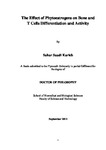The Effect of Phytoestrogens on Bone and T Cells Differentiation and Activity
| dc.contributor.supervisor | Fox, Simon | |
| dc.contributor.author | Karieb, Sahar Saadi | |
| dc.contributor.other | Faculty of Science and Engineering | en_US |
| dc.date.accessioned | 2012-12-12T15:56:20Z | |
| dc.date.available | 2012-12-12T15:56:20Z | |
| dc.date.issued | 2012 | |
| dc.date.issued | 2012 | |
| dc.identifier | 10190997 | en_US |
| dc.identifier.uri | http://hdl.handle.net/10026.1/1237 | |
| dc.description | Full version unavailable due to 3rd party copyright restrictions. | |
| dc.description.abstract |
The fall in circulating oestrogen (E2) after the menopause leads to an increased rate of bone remodelling, excessive osteoclast activity and a greater fracture risk. Until recently hormone replacement therapy (HRT) was prescribed to post-menopausal women to prevent bone loss, however HRT is associated with an elevated incidence of cardiovascular disease, stroke and cancer. These side-effects led to an interest in naturally occurring compounds with oestrogenic action such as phytoestrogens (PEs), which are non-steroidal-plant derived compounds. Human trials and animal studies suggest a beneficial effect of PEs on bone mass, although their ability to modify osteoclast formation in response to key inflammatory cytokines has not been examined. The aim of the following studies was to determine the effect of physiologically relevant concentrations of genistein, coumestrol and daidzein on TNF-α-induced osteoclast formation, osteoblasts differentiation and T cell activity. Genistein (10-7 M), daidzein (10-5 M), and coumestrol (10-7 M) significantly reduced TNF-α-induced TRAP positive osteoclast formation and bone resorption, which was prevented by the E2 antagonist ICI 182,780. The suppressive action on osteoclast formation was associated with a significant reduction in TNF-α-induced c-fos and NFATc1 mRNA expression and NFATc1 nuclear translocation. Constitutive c-fos expression prevented the inhibitory action of PEs on osteoclast differentiation, resorption and NFATc1 expression. The effect of PEs, in the presence or absence of the anabolic nutritional factor zinc, on osteoblasts differentiation and bone nodule formation was examined in-vitro. Coumestrol (10-5 to 10-7 M), daidzein (10-5 to 10-6 M) and genistein (10-5 M) enhanced bone nodule formation and ALP activity in human osteoblasts, and this effect was significantly augmented in the presence of zinc (10-5 M). Furthermore, PEs and zinc increased Runx2 mRNA expression and Zn2+ augmented the inhibitory effect of PEs on RANKL/OPG ratio. This suggests that in addition to the direct inhibitory effect on osteoclast formation PEs also in-directly reduce the osteoblastsic stimulus for osteoclast formation and promote bone formation. E2 deficiency is thought to promote osteoclastogenesis by modifying Thelper1 (Th1) cell proliferation and inflammatory cytokine production in particular TNF-α. I therefore examined the effect of PEs on T cell proliferation and inflammatory cytokine production. All PEs prevented the augmentative effect of con A stimulated T cells on osteoclast formation in co-culture. However the mechanism of action varied, genistein reduced con A stimulated TNF-α, IL-1β and RANKL expression with little effect on viability, coumestrol decreased cell viability and TNF-α expression whereas the inhibitory effect of daidzein was mediated via suppression of viable T cell number. This study provides novel evidence that PEs have multiple effects on bone cell activity, directly inhibiting TNF-α-induced osteoclast formation, reducing the osteoblasts and T cell derived stimulus for osteoclast formation and augmenting osteoblasts differentiation and bone formation. Thus, PEs have a potential role in the treatment of post-menopausal osteoporosis and inflammatory skeletal disorders and that the beneficial effect noted in previous studies is mediated through multiple mechanisms. | en_US |
| dc.description.sponsorship | Ministry of Higher education and scientific research/Republic of Iraq | en_US |
| dc.language.iso | en | en_US |
| dc.publisher | University of Plymouth | en_US |
| dc.subject | Osteoclast | |
| dc.subject | Osteoblasts and T cells differentiation | |
| dc.subject | Phytoestrogens | en_US |
| dc.title | The Effect of Phytoestrogens on Bone and T Cells Differentiation and Activity | en_US |
| dc.type | Thesis | |
| plymouth.version | Edited version | en_US |
| dc.identifier.doi | http://dx.doi.org/10.24382/3386 |
Files in this item
This item appears in the following Collection(s)
-
01 Research Theses Main Collection
Research Theses Main


